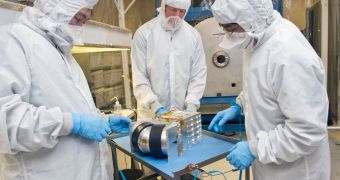An international group of researchers from four different teams met last week in the United States, to test critical components in an instrument that will be installed on the upcoming NASA Magnetospheric Multiscale (MMS) mission.
It consists of four identical spacecraft that will fly in formation high above Earth's atmosphere. The mission is being managed by NASA and a series of Japanese partners. Currently, the experts are working on putting together the instrument suite that will go on the satellites.
The purpose of MMS is to study magnetic reconnection, a phenomenon that occurs when two or more magnetic field lines cross. This creates an impressive burst of energy that can lead to the formation of impressive auroras (if it happens above Earth) or immense solar flares (if it happens above the Sun).
These events are extremely energetic, since they can be measured in megatons of TNT. NASA plans to launch the MMS spacecraft in 2014, with the express purpose of studying magnetic reconnection. The satellites are technologically advanced, since surveying this phenomenon is a very complex task.
The Fast Plasma Instrument – under development at the NASA Goddard Space Flight Center, in Greenbelt, Maryland – needs to be able to create a full map of the sky about 30 times per second. This rate is necessary because magnetic reconnection occurs over small areas at high speeds.
FPI is therefore 100 times faster than any other instrument in its class. “Imagine flying by a tiny object on an airplane very rapidly,” explains GSFC FPI co-investigator and team member, Craig Pollock.
“You want to capture a good picture of it, but you don't get to just walk around it and take your time snapping photos from different angles. You have to grab quick shots as you’re passing. That's the challenge,” the expert goes on to say.
The instrument contains parts built at GSFC, the San Antonio, Texas-based Southwest Research Institute (SwRI), and Meisei Electric Company, Ltd. in Isasaki Japan. Tests are conducted at GSFC, the NASA Marshall Space Flight Center, and the Institute of Space and Astronautical Science near Tokyo.
Last week, experts from all teams met in Huntsville, Alabama, at the US National Space Science and Technology Center's (NSSTC) Low Energy Electron and Ion Facility (LEEIF), where a critical component of the FPI, the Dual Ion Spectrometer (DIS) flight sensors, was tested.
Each of the four satellites will feature a FPI. In total, the experts need to build 16 DIS, 16 Dual Electron Spectrometers (DES) and 6 Instrument Data Processing Units (IDPU).

 14 DAY TRIAL //
14 DAY TRIAL //